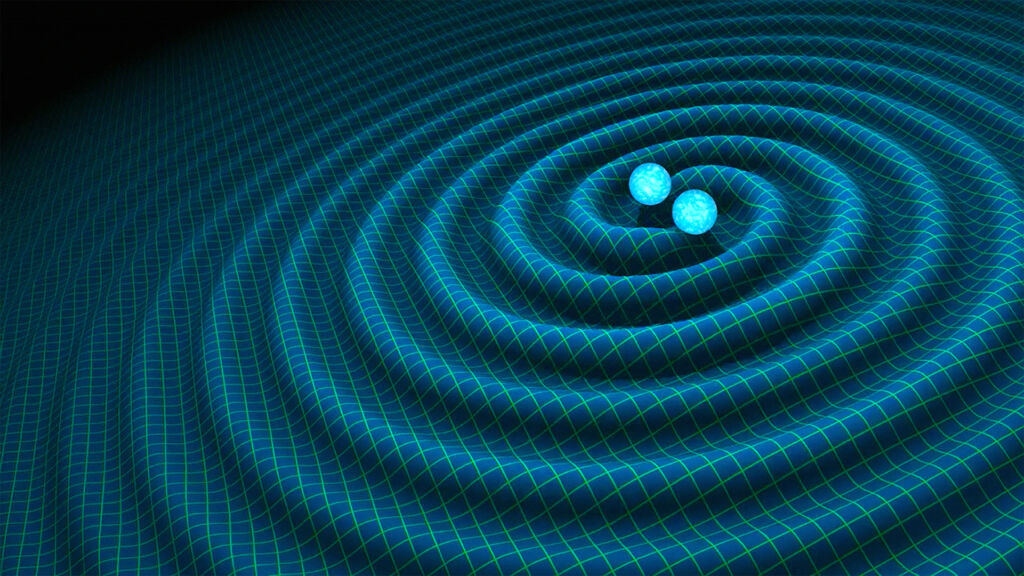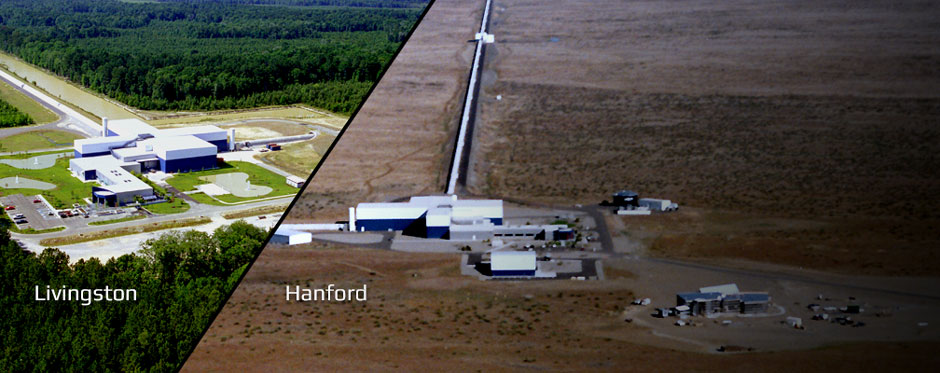Talking to one another or throwing a rock in a still pond will create waves that affect the mass around the epicenter, creating peaks and troughs. Similar to sound or water waves, gravitational waves are undulations in the space-time continuum that propagate with the speed of light. With a period and amplitude, these oscillations are like any other wave that you can find in nature. Albert Einstein originally hypothesized the existence of gravitational waves more than a hundred years ago, however, we had never detected these waves until recently. Laser interferometers, a century old optical technology is sensitive enough to capture these waves that propagate towards us from far away.
From millions to billions of lightyears away there might be a spinning neutron star that pulses. Or two of them spin around each other, getting closer and closer and losing energy through the process of radiating gravitational waves. No matter the source, these powerful waves created by naturally occurring phenomena will shake the entire universe. In this blog post we will explore some of the interesting questions around the gravitational waves:
- What are gravitational waves?
- How do laser interferometers detect gravitational waves?
- How reliable are the measurements from laser interferometers?
- New developments with laser interferometers
- Can we detect earthquakes through gravitational waves using laser interferometers?
1. What are gravitational waves?
Gravitational waves are distortions in space-time continuum that have the ability to move mass and propagate with the speed of light. Like all other waves, these undulations have peaks and valleys and behave similarly to other waves such as electromagnetic waves. As large, massive objects travel through space-time they distort it creating undulations almost the same way as when a charged particle of a magnet moves and creates electromagnetic waves. The concept relies on the notion that gravity is simply the warping of space-time continuum around a massive object.
As the cosmos is abundant with ultra-heavy objects they invariably generate gravitational waves as they move around. The strongest of these waves get generated during violent cosmological events such as merging or collision of stars. While the existence of such waves was postulated more than a century ago, it took nearly 60 years to find the first evidence of it in 1974. Astronomers in Puerto Rico, had discovered a pair of spinning pulsars, which were gradually approaching each other. The rate at which they were approaching each other was in line with the rate of gravitational energy dissipation if they indeed emit waves as the theory predicted. While not a direct proof or detection of gravitational waves this was the first inferred evidence of their existence.

Gravitational waves are created by two spinning neutron stars. Image courtesy of Space.com.
2. How do laser interferometers detect gravitational waves?
It turns out these waves can be detected by incredibly precise instruments. The first gravitational wave was detected on September 14, 2015, by a team of researchers working in the Laser Interferometer Gravitational-wave Observatory (LIGO). This was an exciting find for researchers around the world since previously, gravitational waves were only a theoretical possibility. What they found was amazing: billions of lightyears away there was a massive collision of two black holes that were each the size of 30 Suns merging into one. Scientists had devised clever methods to detect gravitational waves generated many light-years away down here on Earth!
Einstein’s theory states that the waves will distort space and time, hence any mass that it is passing through. To detect this movement, a tunnel in an L-shaped manner was created where two lasers bounce back from a mirror and combine to create a single laser interference. These laser detection systems are also called laser interferometers. The source beam pulse will pass through a beam splitter where the light will split. Each beam of split light will travel to a mirror and then bounce back to the original beam splitter where they will recombine. If there is a slight displacement between the two mirrors due to gravitational waves, the reflected light will combine at different times. For example, one mirror lengthens and the other will shortens, creating a change in signal and proving gravitational waves.

The basics of laser interferometers. Image courtesy of Ligo Scientific Collaboration.
3. How reliable are the measurements from interferometers?
A huge issue with light is that it undergoes diffraction and scattering in the air, colliding into air molecules and reflecting off into unknown directions. If you ever looked at distant mountains, you can see that they are a bit unclear and foggy, this is exactly due to the air and water molecules in the air preventing the reflected light to travel a far distance. This is affected by temperature, pressure, humidity, and CO2 concentrations and is called the refractive index of air. Due to this, the facility had to be vacuumed of all the air located in the 4km tunnels to prevent any scattering of light. This makes LIGO able to detect movements of up to 1/10,000th the width of a proton!
With this incredible accuracy, any movement in the ground will disrupt the lasers and cause noisy data that has no real use to scientists. To counteract the effect of noise from atmosphere, as well as vibrations on the ground here on earth, scientists have devised a clever method. The scheme would take use of two spatially separate measurements so that any environmental noise be it from atmosphere or ground vibrations will be totally independent and out of sync, so that the only signal in synch will be extraterrestrial. The distance between two two-wave detectors located 3000km away from each other was large enough that would eliminate noise caused by a moving truck outside or even a regional earthquake.
Researchers were then able to observe and compare data from the two sites to determine if the movement was actually caused by a gravitational wave; if there was a spike in the signal observed at one lab, but no signal was captured at the other lab, then it might have been just a false alarm. With this method, researchers can ensure that they have indeed detected a gravitational wave.

Two Ligo labs located at Livingston and Hanford. Image courtesy of CalTech.
4. New developments with laser interferometers
Using the same concept of laser interferometry scientists are able to devise other (than L-shaped) geometries of laser interferometers that can be significantly more sensitive that the ancestor prototype. While the original classic setups have been improved by increased interferometer arm lengths and mirror pairs, the sensitivities still leave room to be desired. Each mirror pair in an interferometer introduces new light distortions and causes excess noise in the detector. So there is a tradeoff between increasing path length and introducing new distortions of the laser beam profile.
Researchers in Australia have come up with a fundamentally new method that could materially improve the sensitivity of measurements. They have used an etalon with an imprinted metastructure on its surface. A prescribed special pattern has been encoded as a metastructure at a sub-wavelength scale. As the back-reflected light gets detected through multiple detectors, the surface metastructure can be reconstructed. Their original experiments indicate a 1,000x improvement in the sensitivity of traditional laser interferometers. This technology can be applied to improve the sensitivity of gravitational wave detection.

Scientists discover a new method for detecting gravitational waves. Image courtesy of the University of Western Australia.
Separately, in the realm of currently available systems, a new mission called the laser interferometer space antenna (LISA) is scheduled to be completed in 2024 and launched by 2030. This space antenna will be 2.5 million km apart and will use laser interferometers shaped in an equilateral triangle to detect gravitational waves. It will be in orbit around the Sun and trail the Earth 20 degrees behind it. Scientists discovered that this technology is five times more accurate than they had previously predicted. With better technology, we can detect fainter waves which ultimately means that we can see further into the past.

Comparing different gravitational wave detection methods. Image courtesy of Universe Today.
5. Can we detect earthquakes through gravitational waves using laser interferometers?
Similar to gravitational waves, earthquakes can also mimic the same characteristics as they can displace the ground underneath your feet. Currently, we have no precise method to detect earthquakes. The seismic waves produced by earthquakes travel close to six kilometers per second so faster detection is key. Placing multiple seismic sensors around an area is a solution, but the readings might take seconds or minutes before any warning can be delivered to people in the path of destruction.
Due to the incredible changes in mass when an earthquake occurs, gravitational waves are generated that propagate in space and time. It is possible to utilize LIGO technology to predict when these events occur at the speed of light, rather than at the speed of sound and warn cities ahead of time. These few seconds or minutes can save thousands of lives. Little seismic waves are first detected before the larger waves arrive. Hence, if researchers see a subtle increase in movement, this could be an early indication of a larger and more dangerous wave.
The gravitational signals are not strong enough right now to detect with this technology, as earthquakes only with a magnitude of 8.3 and above can be predicted. Furthermore, locations with a dense region of seismic sensors will not benefit significantly from this new advancement. Due to these limitations, Japan is planning to have one of the first implementations of this technology as tsunamis take 10-15 minutes to travel to land and sensors cannot be dispersed in the ocean.
If you liked this article, you will also like our blog post on Hawking Radiation.
